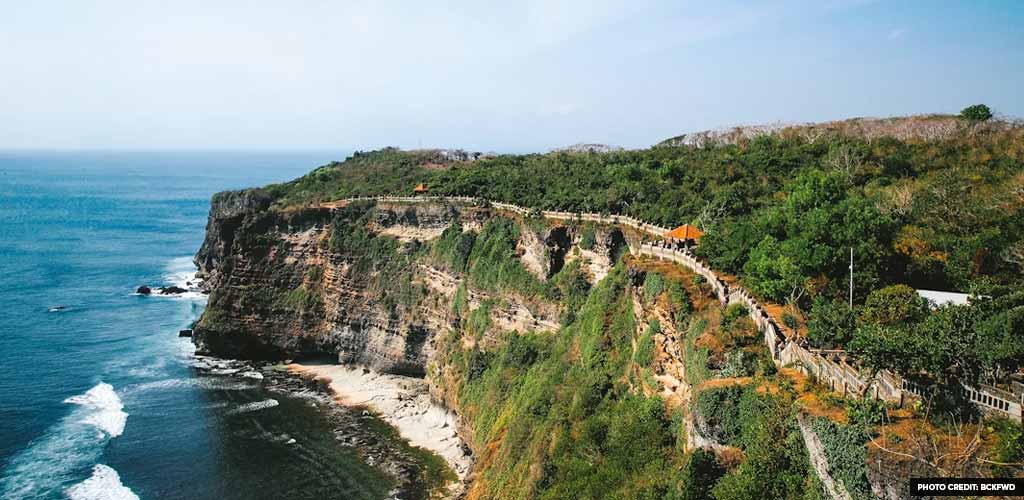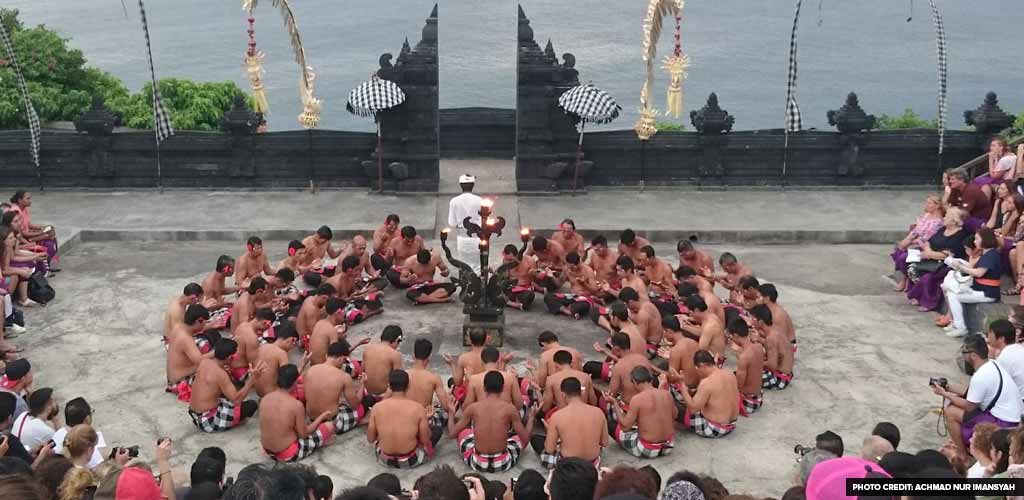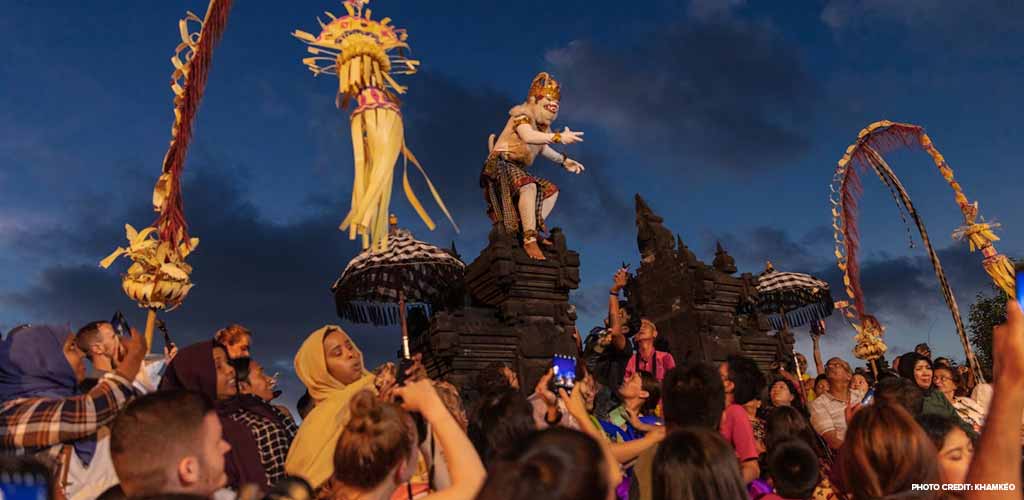
Situated atop a steep cliff 70 metres above the Indian Ocean, Uluwatu Temple is one of Bali’s most iconic spiritual sites. Revered as one of the island’s ‘Sad Kahyangan Jagat’ or ‘six sanctuaries of the world,’ this sacred sea temple protects the island from evil spirits and negative energies believed to approach from the south-west.
In Balinese, the temple’s proper name is Pura Luhur Uluwatu. From dramatic ocean views and cliffside paths to wild monkeys and the hypnotic Kecak fire dance, it combines spirituality, culture, and natural beauty in equal measure.
The Uluwatu Temple dates back to the 11th century and was first established by the Javanese sage Mpu Kuturan—a major figure in early Balinese Hinduism. It was later expanded by Dang Hyang Nirartha, a revered priest who is believed to have achieved moksha (liberation of the soul) at the temple site. His spirit is said to be enshrined in the temple, and the word ‘Luhur’ in the name signifies its status as a holy and elevated place.
The temple is dedicated to Sang Hyang Widhi Wasa, the Supreme God of Indonesian Hinduism, manifested here in the form of Rudra, the god of wind and storms. Another legend claims this is where Brahma, Vishnu and Shiva—the Hindu trinity meet and is the embodiment of Tri Hita Karana. Additionally, the temple is considered especially sacred because of its role in guarding Bali’s spiritual balance from the southern seas.
Uluwatu’s most striking feature is its dramatic location. Sitting at the edge of a limestone cliff, the temple overlooks miles of open sea, making it one of the most photogenic spots on the island, especially during golden hour.
The architecture is traditional Balinese, complete with split gates (candi bentar), stone carvings, and ‘meru’ towers with thatched multi-tiered roofs. While the inner sanctum is reserved for worshippers, visitors can explore the temple’s outer and middle courtyards, wander along paved paths that hug the cliffs, and take in panoramic views of the ocean. The place is a photographer’s delight and it’s rare to not see tourists and locals alike clicking away happily.
The temple grounds are home to a large population of long-tailed macaques. They are considered to be spiritual embodiments of Hanuman—the warrior monkey god from Ramayana. Though, reality appears otherwise. These four-legged denizens of the temple are notorious and many have learned to snatch loose items like sunglasses, hats, and even phones.
Visitors are advised to keep valuables secure and out of sight. When clicking photographs, ensure cameras and mobiles are held tightly and not put in the open where they may be easy targets. Do not wear flashy jewellery. They glint in the sun and monkeys are drawn to shiny objects like… monkeys to shiny objects. Also, refrain from trying to feed the monkeys at odd hours or all alone, and a lonesome visitor might suddenly find himself mobbed by 20 or more overeager simians. The temple organises feeding tours and willing visitors may participate. Lastly, avoid making direct eye contact with the monkeys. They see it as a territorial challenge and will attack, often in groups. Like other wild animals, sometimes it’s simply best to observe them from a distance.
Despite best efforts, it may so happen that a monkey may find its way to a visitor’s valuables. If this happens, do not try to snatch the object from the monkey. It may attack, or worse, throw the object down the cliff. Instead, ask the local guides or the temple administration for help. As astonishing as it sounds, they can help retrieve the stolen item by bartering with fruits and snacks, in which case be prepared to lose the entire packet—a chip simply won’t do. While the monkeys are part of the temple’s charm, a little caution goes a long way.

A lesser talked about thing to do at Uluwatu is spending a moment discovering its statues. The temple complex is popular with the locals for its Kumbhakarna and Danghyang Nirartha sculpture. Kumbhakarna’s statue is set against the backdrop of the cliffs and is done in white with gold accents. The graven image shows the demon warrior mid-battle, fighting a band of monkey soldiers. Kumbhakarna fought Lord Rama not out of malice or hatred but from a sense of duty towards his brother and king Ravana. The sculpture symbolises traits like sacrifice, devotion and moral integrity—values closely associated with the Hindu religion.
The other well-known statue is that of Danghyang Nirartha. Hewn out of light grey rock, the graven image pays homage to one of Bali’s best known priests and his contribution towards spiritual upliftment of the masses and temple building. He is, in fact, credited with bringing to life the Pura Luhur Uluwatu as it is today and is said to have attained liberation on these very grounds. The statue of Danghyang Nirartha is a reminder of wisdom, spiritual guidance and enlightenment.
Uluwatu is one of the best places in Bali to watch the sunset. As the sun dips into the ocean, the temple’s silhouette becomes more pronounced, framed against a backdrop of glowing orange and crimson skies. The waves below continue to crash, creating a dramatic background score to the natural spectacle. Most guests time their trip to arrive by 4:00 PM. This allows ample time to explore the temple complex before grabbing a good spot for sunset—and for the main evening event: the Kecak fire dance.
Having said that, please be advised that public transport in and around Uluwatu is fickle and sometimes, non-existent. If travellers are staying back for the sunset and the fire dance, please ensure return transportation.
Every evening around 6:00 PM, the open-air amphitheatre near the temple hosts a Kecak dance performance. Unlike other Balinese dances, Kecak features no musical instruments—just the rhythmic chanting of ‘cak cak cak’ by dozens of bare-chested men who form a circle around the performers. The dance narrates episodes from the Ramayana, focusing on the story of Prince Rama, his wife Sita, and the demon king Ravana. As dusk falls, torches are lit, and the performance intensifies with fire, movement, and haunting chants. It’s immersive, emotional, and deeply tied to Balinese cultural traditions.
Tickets to the show are not included in the entry price and must be purchased separately. As of July 2025, the tickets typically cost IDR 100,000–150,000, roughly AUD 10-15.
The Uluwatu Temple is in the southern region of Bali and nearly an hour’s drive from the International Airport. Individual distances will vary, based on where the visitors are arriving from. Holidaymakers travelling from Jimbaran and Nusa Dua will usually encounter a brief 40-minute drive while those coming all the way from Ubud can see their travel stretch up to 3 hours.

The temple opens at 7am before shutting its gates at 7pm. Do note, this applies to the visitors only. Uluwatu, the sea temple, is open to Hindu devotees for 24 hours in a day. Entry fees as of July 2025 is IDR 50,000 for international adults and IDR 30,000 for children (AUD 5-3). The fee includes a sarong and a sash rental, both of which are mandatory for entering the temple grounds.
If travellers want to explore the temple at their leisure, reach there post breakfast. There’s plenty to soak in, right from the temple architecture to the small deities in the temple’s meru as well as the tiny empty sanctuaries. Holidaymakers will also benefit from reaching the sea temple between 4:00-4:30 pm. This provides ample time to have a well-paced tour of the temple and wrap it up in time for the Kecak performance.
Having said that, most visitors usually have an itinerary that includes covering the beach and other nearby attractions in Kuta. Plus, there are eateries in and around the temple and so, arriving a little early is just good planning.
Pura Luhur Uluwatu is located in Pecatu Village, South Kuta, Bali. Away from the bustle of touristy areas, there’s not much happening here. Therefore, availing public transport or popular ride sharing options are a test of luck. Instead of trying their luck out, especially after dark, it’s just better and les stress to have a hire car pre-booked. Hotels are usually able to provide one on notice. If not, there are many local hire-cab services, though spot bookings can get expensive.
Travellers in Bali can also drive up and down the island on their own. But challenges exist in the form of signage, language barrier, driving rules and of course, chaotic traffic. Travellers can also ride a scooter or a motor bike to the temple – do wear a helmet.
Nearby attractions at the Pura Uluwatu are limited to beaches and eateries, with a park thrown into the mix to make it interesting. Visitors will want to check out the Labuan Sait beach or Padang Padang as it’s more popularly known. Its appeal lies in its seclusion, sparse crowds, calm waters and the cliffs surrounding it. Then there’s the Blue Point Beach with its caves and the Balangan Beach, famous for its golden sands.
Like always, an hour or two by the beach promises plenty of swimming, sunbathing and snorkelling for those so inclined. In fact, it’s a great way to begin the day, eating out at one of the nearby food stalls and winding up the day with a tour of the Uluwatu temple. For a quick sortie after lunch, holidaymakers can also visit the Garuda Wisnu Kencana (GWK) Cultural Park, home to one of the world’s tallest statues.
It’s a temple, there’ll be hard rules and some recommendations. For starters, wear walking shoes or at least ones with thick soles – leave sandals and thongs at the hotel. Carry water and snacks, as there’s plenty of walking. Plus, they also happen to be excellent bargaining chips if a monkey holds a guest to ransom… but let the local guide or temple management do the negotiation. Then, the entry ticket includes the cost of a sarong and sash – use them. As a place of worship, it is customary to cover oneself. That means no showing off shoulders, arms or legs – keep them covered. Respecting the temple rules is an excellent etiquette. Do not enter the temple’s inner sanctum and leave dedicated halls and prayer spaces for worshipping Hindus.
A point that cannot be stressed enough – take pictures of the gods’ statues, not selfies! When taking photos, do not pose with deities – it’s simply disrespectful. Secondly, avoid touching the centuries-old statues and idols. Tourists have also taken pictures of themselves bro-hugging statues and it’s just not done. Photography is permitted in most places but it’s always advisable to check with the temple management. Also, drone photography is strictly prohibited and requires prior permission.
This last point will appear archaic, but women on their periods are not permitted to enter the temple itself. They may, however, make full use of the temple’s grounds and other spaces. This is a customary rule in Hinduism.
The Uluwatu Temple is one of those rare destinations where natural beauty and cultural heritage meet—a place that stirs both awe and reverence. From its sacred clifftop setting (Ulu meaning head and Watu meaning rock) to the rhythmic energy of the Kecak dance, every element of the experience is rich with symbolism, history, and spectacle. Whether travellers seek a spiritual journey, or are an art lover, or a casual traveller looking for the perfect photo spot, Uluwatu Temple is a must-visit on any Bali holiday. Speaking of itineraries, our travel specialists can help make one that’s personalised — just call 1800 991 751!
Scan QR image with Google Lens

Or fill your email address below